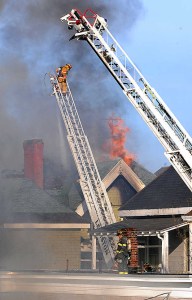LEWISTON — City firefighters have gone over 888 days — about two and a half years — without a labor contract.
“The guys are frustrated,” said Capt. Rick Cailler, president of the Lewiston Firefighters IAFF Local 785.
The disagreement is staffing, both sides said.
Cailler said national firefighter safety standards call for four firefighters for every pumper truck, five for every ladder truck.
“We have only three” for each truck, he said.
For a city with old housing stock built close together, Lewiston firefighters are advocating for safe staffing “while the city chooses to turn a blind eye,” Cailler said.
In 1980, Lewiston employed 108 firefighters. “We’re down to 64,” Cailler said.
The limited manpower and dense neighborhoods place residents and firefighters at a higher risk, he said. The city is not only resisting hiring more firefighters, it’s asking for concessions in the contract, Cailler said.
Adding more staff to each truck per shift would be expensive, he acknowledged, but it would be safer.
“The men and women of the Lewiston Firefighters Association come to work each day to protect our citizens and that will not change,” Cailler said in a statement.
Firefighters will do their best with the staffing they’re given, he said, adding that every firefighter wants to go home at the end of his or her shift.
Adding one more position to each ladder truck and pumper truck would mean hiring 20 firefighters, a cost of about $1 million, Lewiston Fire Chief Paul LeClair said.
That would mean higher property taxes, which would be a strain on taxpayers, City Administrator Ed Barrett said.
Saying he generally doesn’t comment while labor negotiations are ongoing, Barrett said the city has reduced staffing in recent years.
“Not just in the Fire Department but in all areas of the city,” he said. Some fire stations, including Lincoln Street, have been closed, he said.
In 2001, the city had 412 workers; that number is down to 340, Barrett said. “Since I’ve been here we’ve had significant staff reductions that have hit every department.”
A few Fire Department positions, including a prevention officer, have been restored to deal with safer housing, Barrett said.
As far as staffing firetrucks with the national recommendation of four or five instead of three, more than three per firetruck “is not what you’re going to find in Maine. Most communities operate with three firefighters,” or have volunteer firefighters.
Any additional expense in the Fire Department’s budget has to be decided by the City Council, “which has to balance expenses against priorities,” Barrett said.
Labor negotiations are continuing, city officials said.
“We’re doing our best to keep the lines of communication open,” Chief LeClair said. “It’s the only way to make progress.”

Comments are no longer available on this story